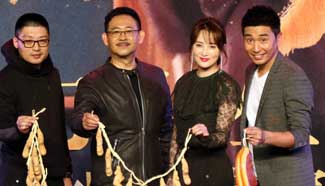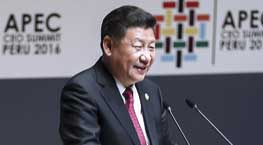By Xinhua writer Liu Wei
BEIJING, Dec. 8 (Xinhua) -- Huang Xijiu received her first-ever bank statement last month - it showed a deposit of 4,800 yuan, well above 3,000 yuan annual per capita income in her village.
But that was for just two months' work, stitching away at traditional Miao embroidery as generations of Miao women have done before her.
Huang, 53, was overjoyed at receiving her first windfall from embroidery. "My father-in law, mother-in law, my husband and my daughter-in-law all praised me and they said I earned more than they did," Huang recalls. "I'd rather do this than feed pigs and chickens. I feel proud of myself."
Huang picked up her sewing skills as a girl from her mother in Jidao village, Qiandongnan Miao and Dong Autonomous Prefecture of China's southeastern Guizhou Province.
She soon mastered various embroidery methods, winning two competitions in Kaili, the prefecture seat. Like many Miao women, Huang viewed embroidery as a way to record life and decorate festive occasions - never as a bread-winning skill.
Many young Miao women have left the poverty and isolation of the village to make a living in China's cities. Gifted as Huang is, she lacks the ability to develop herself as well as access to financial services. "Many of us can barely read or write, so we have no idea how to commercialize our cultural heritage," says Huang.
Despite China's enormous achievements in poverty reduction in recent decades, ethnic minority women are disproportionately disadvantaged by poverty.
"They need targeted measures to be lifted out of poverty. That's why we, together with the China Soong Ching Ling Foundation (CSCLF), introduced the Weaving into Happiness program in the prefecture," says Agi Veres, the country director of the United Nations Development Programme (UNDP) in China. "The program empowers Miao women to use their embroidery skills so they can make their own livelihoods and opportunities and preserve their culture as well."
Begun at the end of 2015, the program invited a Miao embroidery master to test the skills of the local Miao women and pay them according to each sewing assignment.
The first workshop involved fewer than 20 women and the few who finished the assignment with their best efforts got 200 yuan, but most received nothing.
"They didn't believe they'd get a free ride at the beginning. But the second time, almost every woman joined the program," says Huang, sewing with two needles - one leading a thread to and from loops, and the other back-stitching. This double-needle stitch had been disappearing in the village over the last 60 years, but the program revived it.
The program has organized three embroidery workshops over seven months and 46 out of 60 women became skilled seamstresses. The UNDP and CSCLF also trained them in business skills, helping them win orders from fashion brands.
Chen Qin, 36, one of the few villagers who can speak fluent Mandarin, served as a village doctor for many years. In 2015, she noted how the remaining women in the village, the elderly and the children were still living a hard life - with most of the men having left for more developed areas - so she started a microbusiness collecting hand-made silver ornaments and embroidery to sell online in a bid to raise living standards.
However, a lack of business acumen and management experience held the venture back. So when "Weaving into Happiness" arrived in Jidao, Chen went door-to-door to encourage other Miao women to join.
"Unlike urban women who often have stable jobs and are said to 'hold up the half sky', Miao women mainly work around the home. So earning money through embroidery was quite beyond their imagination," says Chen.
Chen also runs her family guesthouse, which has provided unique opportunities to connect with others interested in cultural preservation and sustainable village development. Tourists come not just for the fresh air, but also to learn about Miao culture.
Chen's annual earnings have risen fivefold over the last two years to 100,000 yuan, but her greatest satisfaction comes from seeing more villagers create opportunities for themselves - and even some young women returning to learn embroidery.
"In this way, young mothers can stay with their children. There is more laughter on those children' s faces," Chen says.
The embroidery program will run three years in its first phase, and has expanded to workshops in neighboring Maomaohe village. Many Miao women from nearby villages are also keen to join.
In Maomaohe, villagers formed an embroidery cooperative. At the first training session in November, the tutor asked them to draw familiar ethnic totems on paper and explain the meanings behind the symbols.
"In the following workshops, we will try to tap the potential of local people and ask them to capitalize on their resources to broaden both domestic and overseas markets. In this way we might develop a tiny program into a social enterprise," says Gu Qing, assistant director of the UNDP in China.
Embroidery is just one Miao specialty, says Chen. "We are also good at singing. We really should make good use of what we have to develop the village. There is a saying that it is always better to teach a hungry person to fish than to give them fish."
She suggests all the seamstresses give 3 yuan of every 100 yuan they earn to a "seed foundation" , which now has a fund of 5,600 yuan.
"I want the program to be self-sustainable and expect it to train more management and marketing talents," says Chen. "We' d like to encourage more ethnic minority women to join us and shake off poverty."










